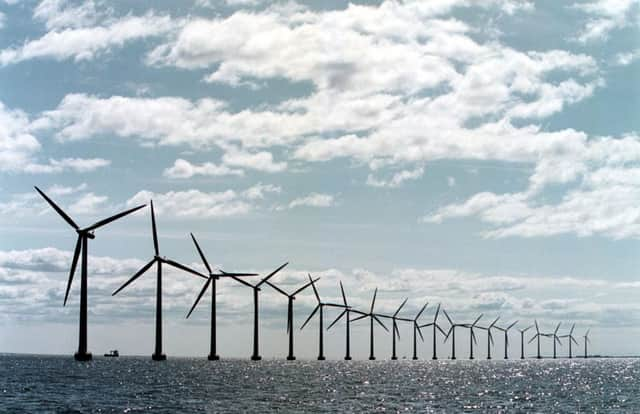The heat is on as energy clash looms


IT SHOULD have been a cause for the energy industry to celebrate. New figures released last week showed that wind power had risen by more than a third to a record high.
But anyone thinking of throwing a party had their hopes dashed when SSE, one of Britain’s big six suppliers, scrapped plans to invest £20 billion in four major offshore projects.
Advertisement
Hide AdAdvertisement
Hide AdThese included about half of the current planned capacity along the east coast of Scotland. Furthermore, the company also questioned “the viability of the wider offshore wind sector”.
Such warnings were particularly stark coming from Scottish Hydro owner SSE, previously one of the staunchest backers of renewables in the industry. The company blamed limited government support for offshore wind as one of the two main reasons for its decision, a rationale that drew the ire of energy secretary Ed Davey.
“If SSE are moaning ‘our project won’t go ahead because of the levy control framework and costs’, do I care? No,” he was quoted as saying. “Are we going to hit our offshore targets? Yes. Are we the best place to invest in the world? Yes.”
The political interventions didn’t end there, with regulator Ofgem announcing an investigation into the broader gas and electricity market the following day. The move prompted Centrica chief executive Sam Laidlaw to declare that the company would delay investment in new gas-fired power stations until the two-year inquiry is complete.
“Clearly, if we have this competition referral our ability to invest is going to be handicapped, because you wouldn’t invest in new power generation if there was a possibility that you might have to divest as a result of a competition referral, so that has heightened the political risk during this period,” Laidlaw said in an interview on the company’s website.
Dermot Nolan, the newly installed chief executive of Ofgem, denied the investigation was driven by political pressure. However, UK energy policy has been contentious ever since opposition leader Ed Miliband promised to freeze energy bills at last autumn’s Labour conference.
The industry warned at the time that such a move would throw the sector into chaos, undermining efforts to raise the estimated £110bn of investment needed in coming years to replace polluting power plants while heading off the risk of blackouts.
David Hunter, head of strategic alliances at consultants Schneider Electric, said the referral was driven by the need for politicians to look as though they are doing something to tackle soaring domestic fuel bills. The amount paid by the average UK home has more than quadrupled in three years, according to Ofgem.
Advertisement
Hide AdAdvertisement
Hide AdWith the investigation set to take two years, the issue will remain a high priority through the independence referendum this autumn and on into next year’s general election.
“What comes out at the end of those pressures is a risk of a cutback on investment, and that investment is desperately needed,” Hunter said. “The most likely scenario remains that the lights don’t go out, but it is absolutely right to say that things look uncomfortably tight in the second half of this decade.”
The power fault lines run not just between the political parties, but also separate those on either side of the independence debate. Yes campaigners maintain that the UK government’s continuing support for nuclear energy comes at a cost to renewables. On its own, Scotland would better be able to maximise the benefits from green power sources.
“The UK government’s delayed energy market reforms are threatening the vital investment required – which SSE also made clear in their statements this week,” a Scottish Government spokesman told Scotland on Sunday.
“Westminster’s continued enthusiasm is at odds with its lukewarm support for the offshore renewables sector. The possible £35bn subsidy for one new nuclear power station at Hinkley Point C sits in stark contrast to the £43bn which the UK government has assigned to support all low carbon technologies across these islands.”
Niall Stuart, chief executive of Scottish Renewables, said SSE and the other “Big Six” energy providers were at the centre of a number of conflicting demands: the need to keep prices as low as possible; the drive to develop new technologies; raising investment for new generating plants and better transmission networks; and the need to ensure energy security.
“It is pretty clear now that they can’t do all of that on the scale we previously thought they could,” Stuart said.
Both renewable and traditional generators say the changing regulatory environment is holding back investment in new plant capacity. These uncertainties were meant to be laid to rest following the lengthy passage of the Energy Bill at the end of last year. The bill ushered in energy market reform, which lays out how clean energy providers receive their guaranteed payments through the new Contracts for Difference (CfD).
Advertisement
Hide AdAdvertisement
Hide AdOne major concern is that there will be a three-year overlap between CfD and the existing system of payments through the Renewables Obligation (RO). While both will draw from the same pot of money, it’s not yet clear how much each channel will be allocated.
Under RO, any wind farm that meets specifications automatically receives support, but financial incentives through CfD are not guaranteed. As the UK’s renewable targets are now within reach, the government has the luxury of selecting only certain projects for backing.
While this has the laudable effect of allowing the government to trim its budget, investors who fund the construction must wait longer to find out whether they will receive any support.
“We are going from a position where everyone got support for their project to a place where government will pick and choose which projects they want to support through the Contracts for Difference,” Stuart said.